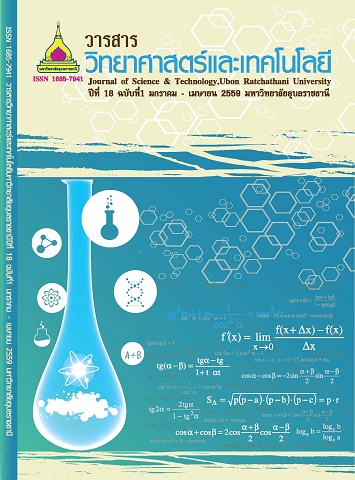การวิเคราะห์เหตุการณ์การปะทุบนดวงอาทิตย์ที่มีความรุนแรงตามประเภทการปะทุในช่วงปี พ.ศ. 2554-2556
Main Article Content
บทคัดย่อ
งานวิจัยนี้วิเคราะห์การปะทุบนดวงอาทิตย์แบบทันทีทันใด วันที่ 3 พฤศจิกายน 2556 ความแรงของรังสีเอกซ์ที่ M5.0 และการปะทุแบบค่อยเป็นค่อยไปในวันที่ 9 สิงหาคม 2554 และวันที่ 29 ตุลาคม 2556 ความแรงรังสีเอกซ์ X6.9 และ X2.3 ตามลำดับ เกิดขึ้นในช่วงพีคของวัฏจักรดวงอาทิตย์ปัจจุบัน เกิดด้านตะวันตกของ ดวงอาทิตย์มีระยะเวลาในการเคลื่อนที่จากดวงอาทิตย์มายังโลกน้อยกว่า 20 นาที วิเคราะห์และจำลองการเคลื่อนที่ของอนุภาคฮีเลียม ด้วยสมการขนส่ง Ruffolo 1995, 1998 ที่ระดับพลังงาน 4.032 - 34.770 MeV/n สำหรับการปะทุวันที่ 3 พฤศจิกายน 2556 และระดับพลังงาน 86.793 - 171.373 MeV/n สำหรับการปะทุวันที่ 29 ตุลาคม 2556 โดยใช้ข้อมูลจากยานอวกาศ ACE (Advanced Composition Explorer) จากอุปกรณ์ SIS (Solar Isotope Spectrometer) และฟิตเปรียบเทียบข้อมูลด้วยวิธีกำลังสองเชิงเส้นน้อยที่สุดเพื่อหาระยะเวลาปลดปล่อยอนุภาคบนดวงอาทิตย์ด้วยการแก้ปัญหาแบบย้อนกลับ และ FWHM พบว่า เมื่อระดับพลังงานเพิ่มขึ้นระยะทางอิสระเฉลี่ยของอนุภาคจะเพิ่มขึ้นและระยะเวลาการปลดปล่อยอนุภาคจากดวงอาทิตย์มายังโลกลดลงตามพลังงานที่เพิ่มขึ้น พบความแปรปรวนของผลสำหรับระดับพลังงานที่น้อยและระดับพลังงานสูงเนื่องจากได้รับผลกระทบจากสภาพแวดล้อมและจำนวนจุดข้อมูลที่น้อยทำให้เกิดความคลาดเคลื่อนสูง การปะทุในวันที่ 9 สิงหาคม 2554 มีความแรงของรังสีเอกซ์และความเร็วลมสุริยะสูง (600 km/s) พบคลื่นกระแทกในช่วงท้ายเวลาการปะทุทาให้เกิดการเร่งของอนุภาคขณะเคลื่อนที่มายังโลกเพิ่มขึ้นกว่าค่าที่วัดได้จากยานอวกาศมาก พบว่าเหตุการณ์ทั้ง 3 นี้ ไม่ส่งผลให้เกิดความรุนแรงต่อสนามแม่เหล็กโลก
Analysis of the Violent Solar Flare Events in 2554 and 2556
This research analyzed the gradual solar flares on 9 August 2554 and 29 October 2556 with x-ray flux of X6.9 and X2.3 respectively, and the impulsive solar flare on 3 November 2556 with the x-ray flux of M5.0. These 3 flare events occurred at the peak of the present solar cycle and their positions were on the west side of the Sun. The injection time of the solar particles was less than 20 minutes. The study simulated the propagation of He with the transport equation of Ruffolo (1995; 1998) in the energy range of 4.032 to 34.770 MeV/n for the solar flares on 9 August 2554 and 3 November 2556, and 86.793 to 171.373 MeV/n for the solar flare on 29 October 2556, used solar particles from the SIS instrument on the ACE spacecraft, and fitted the data by the linear least squares technique. The research found the injection time by the deconvolution technique and FWHM (full width at half maximum), and the results showed that the mean free path of particles increased and the injection time of the particles from the Sun decreased as the energy level increased. It was found that the fluctuation of the results for the low and high energy was because the low energy particles were easily affected by the space environment and the instrument on the spacecraft detected less high energy particles, which caused a high error rate. The solar flare on 9 August 2554 had a high x-ray flux and solar wind speed (600 km/s), and there was a shock wave on the tail of flare, resulting in the injection time being more than the data from the spacecraft. Variation of the Earth’s magnetic field from these solar events was not observed.
Article Details
บทความที่ได้รับการตีพิมพ์เป็นลิขสิทธิ์ของ วารสารวิทยาศาสตร์และเทคโนโลยี มหาวิทยาลัยอุบลราชธานี
ข้อความที่ปรากฏในบทความแต่ละเรื่องในวารสารวิชาการเล่มนี้เป็นความคิดเห็นส่วนตัวของผู้เขียนแต่ละท่านไม่เกี่ยวข้องกับมหาวิทยาลัยอุบลราชธานี และคณาจารย์ท่านอื่นๆในมหาวิทยาลัยฯ แต่อย่างใด ความรับผิดชอบองค์ประกอบทั้งหมดของบทความแต่ละเรื่องเป็นของผู้เขียนแต่ละท่าน หากมีความผิดพลาดใดๆ ผู้เขียนแต่ละท่านจะรับผิดชอบบทความของตนเองแต่ผู้เดียว


